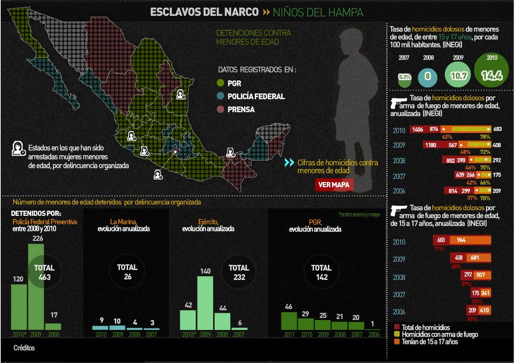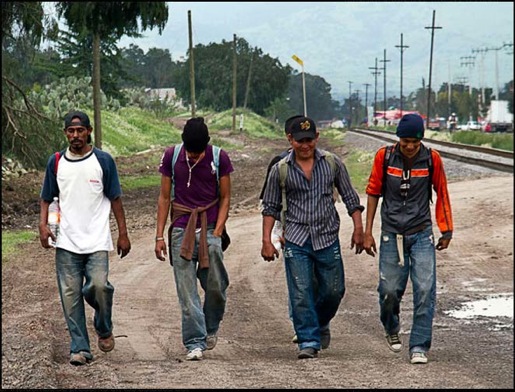The premise of the collaboration was simple: if organized crime can establish and manage a transnational, multibillion dollar business from Colombia to Mexico, surely Latin American journalists can band together to track them.
A collective investigation into organized crime by independent online investigative outlets could reveal how organized crime networks operate and perpetuate human rights abuses, lessen the danger to any one participating media taking on organized criminals alone and increase audience and revenue. The project could transform the way emerging online investigative outlets inform the regional debate.

From this concept, Colaboración sin Fronteras emerged. Verdad Abierta (Open Truth) in Colombia; El Faro (The Lighthouse) in El Salvador; Plaza Pública (Public Forum) in Guatemala; and Animal Político (Political Animal) in Mexico joined together to produce ground-breaking, online, investigative journalism projects related to organized crime in their region.
As part of the collaboration, reporters from these outlets traveled into deserted Mexican villages to document overnight flights of hundreds of families, into abandoned and graffitied houses in San Salvador to determine which gang currently reigns supreme, and into haunting massacre sites in Petén, Guatemala to uncover how agro-industrials collude with local and international armed actors to gain territory. Their final product, The Mafia’s Shadow in the Americas was funded by Internews’ Global Human Rights Project and coordinated and edited by InSight Crime.
The collaboration produced strong reporting, amid high stakes of the investigations. Yet the process of collaboration was not without difficulty, and many of the questions will sound familiar to anyone who has tried to coordinate a collaborative journalism project. This post identifies key questions that should be asked before, during and after the collaborative process and suggestions for how to improve the collaborative model going forward. These findings were also presented at the III International Conference on Cyberjournalism in Porto, Portugal in December.
Why are we doing this?
In prioritizing a democratic collaboration over the final product, Colaboración sin Fronteras suffered an identity crisis. It was never decided whether the ultimate goal was to produce a groundbreaking investigative piece on organized crime, educate participants on investigative and digital reporting techniques, or simply strengthen relationships among the outlets. In the end, the project did not fully accomplish any of these goals. While exposure to new multimedia formats inspired experimentation and all outlets cited an improvement in accuracy, planning and topics covered, this was not necessarily reflected in the final project. The coordination and editing roles were not clearly defined, which caused delays and confusion, further adding to lack of a unified final product.

In the final evaluation of the project, organizers from InSight Crime and Internews pointed out that the quality of reporting was limited by some poor story choices that were out of the reporters’ depth, and there was confusion about the difference between investigative and narrative journalism, resulting in more of the former than the latter. In terms of comprehensive story packages, both Internews and InSight Crime felt there was consistent resistance to exploring new modes of investigation, topics and multimedia content, which came through in a lack of complexity in the stories produced.
Going forward, to define a mission, focus on:
- Determining whether the goal of the collaboration is a quality final product, capacity-building for partners or building relationships within the network.
- Designing a structure that relies on a strict editorial process to develop a unified product, a trainer-trainee dynamic for capacity building and communication and flexibility for relationship building.
- Developing an editorial workflow to meet goals of the project with partners signing a written agreement to comply with structure including communications requirements, deadlines and editorial policies.
What’s in it for me?
Without an overarching objective, participants logically took the opportunity to pursue their particular goals. For some, the most valuable component was the opportunity to bounce story ideas and material off of other high-caliber journalists, while for others funding provided a chance for them to develop their outlet’s multimedia packages. But in all cases, efforts were focused internally, on improving each outlet’s specific content, not on exchanging content or contacts or on building a coherent, cohesive final product.
As Internews and InSight Crime came to realize, without some sort of buy-in from participants beyond their initial interest, it was difficult for participants to put their very pressing individual priorities aside. While all outlets reported that they learned from the planning and editing process during the final evaluation, the planning process and editorial support from InSight Crime were viewed as much more valuable than the mid-investigation check-ins and collective editing process, which were all primarily peer-to-peer activities.
Going forward to ensure participant commitment, focus on:
- Launching an open solicitation with clear selection guidelines for participation to ensure a common purpose.
- Evaluating proposed themes based on project goals and partner’s demonstrated capacity to carry out reporting and ensure all reporters attend coordinating meeting.
- Integrating processes to meet secondary goals such as multimedia reporting development by working directly with the graphics team through a central multimedia coordinator.
How can we do this safely?
Ultimately there was very little change in security awareness or action as a result of the collaboration, indicating the need for more training and resources in this critical areas well as an aggressive digital security plan for high-risk collaborations. Two outlets believed the investigations increased their physical risk, as they planned to publish more sensitive content than was usual for their publication. .Despite having security procedures in place, all the outlets were somewhat more risk averse in sharing information due to lack of digital security mechanisms and therefore only shared information with each other once all sensitive information had been anonymized and stories were nearly ready for publication. Since they were unable to share sources during the active investigations, it was nearly impossible for outlets to uncover connections between criminal actors operating in each country.
Going forward to increase security:
- Conduct a comprehensive physical and digital security assessment for high-risk collaborations and develop security protocol that all partners adhere to.
How is this sustainable?
The most promising finding in terms of sustainability was the participants’ universal desire to continue the relationships developed during the collaboration and a common sentiment that the collaboration became increasingly valuable during the second of two joint investigations. For all participants, building relationships with other partners was one of the major benefits of the collaboration to their media outlet. All outlets identified audience reach, international focus and getting to know partners as key outcomes of the collaboration, and many planned to continue to pursue the partnerships through content-sharing agreements or joint reporting projects. However, only one outlet developed a new financial strategy as a result of the collaboration, and without external funding, it is unlikely that more than two of the partners at a time would engage in a reporting collaboration.
Going forward to create sustainable relationships:
- Integrate an expert in web site optimization and social media marketing to ensure financial benefits for participants and common strategies for ensuring sustainability.
- Extend timeline to at least a year and lower intensity of collaboration.
Eva Constantaras is a Google Scholar and the Internews Data Specialist completing her Master’s degree in Investigative and Data Journalism through El Mundo and Universidad Rey Juan Carlos in Madrid, Spain. She is exploring data journalism approaches for data-poor environments, local data gathering tools and strategies to increase data literacy in developing countries. She writes about these topics on the Internews Center for Innovation & Learning blog and @evaconstantaras on Twitter. Previously, Constantaras worked with the Internews on digital journalism pilots and has managed media development programs in Guatemala, Rwanda, Somalia and Ethiopia. She has conducted trainings and managed programs in investigative journalism, conflict-sensitive reporting, computer-assisted reporting and media literacy. Constantaras’ work as a Fulbright Fellow centered on the safety of journalists in conflict zones in Colombia. Previously, Constantaras was a research associate at the Center for International Media Assistance (CIMA) investigating indirect censorship. She has also worked at UNESCO in Paris and as a reporter at the Seattle Times. Constantaras is based in Madrid, Spain.

